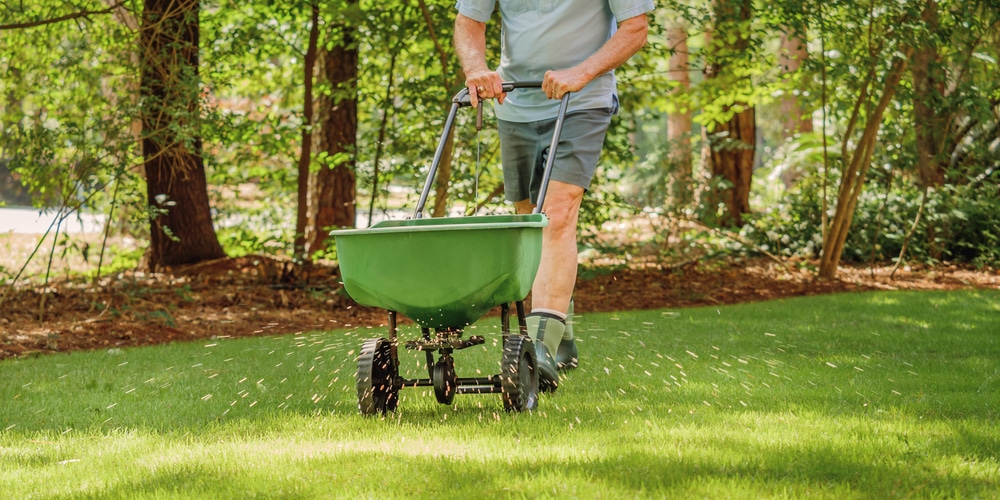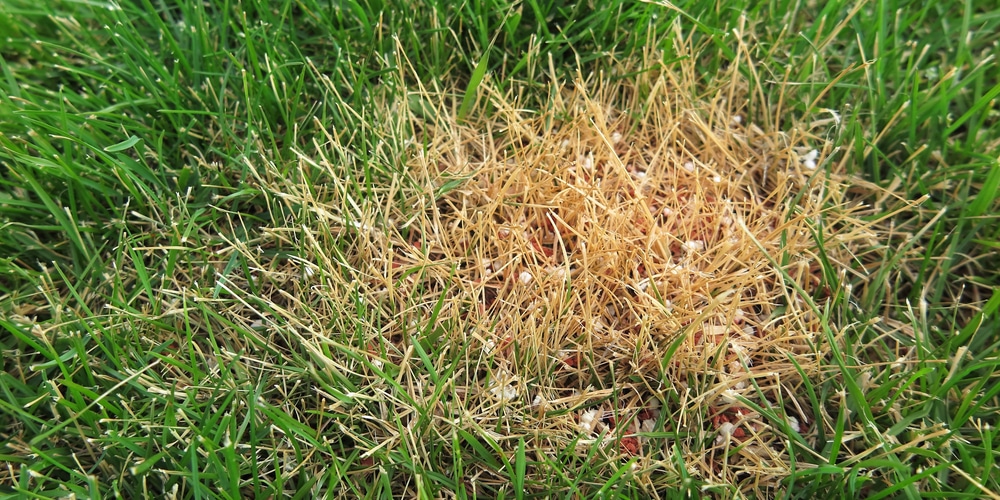Grass Seed Germination: 101
Germinating grass seed is a delicate process. The right balance of water, temperature, and light play critical roles in successful sprout and growth.
Optimal Conditions for Seed Germination
To achieve proper germination of grass seeds, your lawn requires:
- Moisture: Continuous moisture is vital for seed germination. Without sufficient water, the seed cannot swell and initiate the growing process.
- Temperature: Ideal soil temperatures for most grass types hover around 68°F to 70°F (20°C to 21°C).
- Light: A proper balance of light and shade is crucial. Excessive shade may impede growth, whereas adequate light supports photosynthesis.
Phases of Grass Seed Germination
- Imbibition:
- Seeds absorb water and swell.
- Activation of dormant enzymes starts.
- Lag Phase:
- The internal cells begin to divide.
- There’s no visible growth above soil.
- Radicle Emergence:
- The first root, known as the radicle, emerges.
- Soil contact is important for root establishment.
- Shoot Emergence:
- This phase marks the emergence of the shoot above the soil.
- The grass begins to photosynthesize and grow independently.
By maintaining the proper conditions and understanding the germination phases, your grass seeds are positioned to develop into a lush lawn.
Fertilizer’s Impact on Grass Seed Growth
When you’re looking to grow a lush, healthy lawn, understanding the role that fertilizer plays can make all the difference. Here’s how fertilizer helps your grass seeds thrive.
Nutrient Requirements for Grass Seeds
Your grass seeds need a range of nutrients to sprout and grow into a healthy lawn. The primary nutrients include:
- Nitrogen (N): Essential for leaf and stem growth, nitrogen gives grass its vibrant green color.
- Phosphorus (P): Crucial for root development and energy transfer within the plant.
- Potassium (K): Gives grass the ability to resist diseases and withstand stress.
Using a fertilizer with the correct nutrient ratio is vital for seed germination and early grass development. A tip to remember is that phosphorus is particularly important for the early root growth of your new grass seeds.
Types of Fertilizers Suitable for Grass Seed Growth
When selecting a fertilizer for your grass seeds, you have a variety of options:
- Starter Fertilizers: Specially formulated to promote seed germination and root development. Starter fertilizers often have a higher phosphorus content to support new seedlings.
- Granular Fertilizers:
- Slower release
- Offer nutrients over an extended period
- Ideal for long-term nutrition
- Liquid Fertilizers:
- Provide quick nutrient release
- Useful for addressing immediate deficiencies
- Can be easier to apply evenly
Choose a fertilizer with a nutrient balance that’s appropriate for grass seeds to establish your lawn successfully. Always follow the manufacturer’s application instructions to avoid damaging your seeds and ensure optimal growth.
How to Apply Fertilizer
Proper fertilization is critical for ensuring the healthy growth of new grass seed. Knowing when and how to apply fertilizer can support your lawn in becoming lush and green.
Timing and Frequency of Fertilization
- Assess Soil Conditions: Before sowing grass seed, conduct a soil test to understand the nutrient needs of your soil. Adjust fertilization based on these results.
- Initial Application: Use a starter fertilizer when planting new grass seed to provide essential nutrients.
- Follow Up: Apply additional fertilizer after the initial growth period, usually about four to eight weeks post-germination, to continue promoting healthy grass development.
Methods and Techniques for Fertilizer Application
- Spreading Evenly: The goal is to spread the fertilizer uniformly across the soil. Uneven application can lead to patchy growth.
- Use a broadcast spreader for large areas to distribute fertilizer evenly.
- For smaller patches, a handheld spreader can achieve a more controlled application.
- Watering In: After applying, irrigate your lawn lightly to help the fertilizer penetrate the soil and reach the grass seeds. Watering is crucial for activating the fertilizer.
- Safety Measures: Always wear gloves and follow the manufacturer’s guidelines to protect yourself and ensure the correct amount of fertilizer is used.
Effects of Over-Fertilization
Using fertilizer appropriately is critical for the health of your grass seed growth. However, it’s just as important to recognize the harm of overuse, which can lead to issues like fertilizer burn and long-term soil damage.
Identification of Fertilizer Burn
Knowing how to identify fertilizer burn will empower you to act swiftly and minimize damage. Look out for these indications:
- Grass Discoloration: A key sign is a shift in grass color to yellow or brown shortly after fertilizer application.
- Crust of Fertilizer: An excess of visible fertilizer particles forming a crust on the soil’s surface often indicates over-application.
Action: If you suspect fertilizer burn, prompt intervention is necessary to prevent irreversible damage to your grass.
Prevention and Recovery from Over-Fertilization
To protect your lawn from the negative effects of over-fertilizing, consider the following steps:
- Soil Testing: Before applying fertilizer, test your soil to ensure proper nutrient application.
- Fertilizer Type: Select a fertilizer that matches your grass type and soil needs.
- Application Rate: Follow the recommended rate on the fertilizer label; more is not always better.
- Even Distribution: Use a spreader for uniform application.
In case of over-fertilization:
- Watering: Deep and thorough watering can help flush out excess nutrients.
- Cease Fertilization: Avoid further applications until your grass has recovered.
Frequently Asked Questions
When it comes to nurturing your new grass seed, selecting the right fertilizer and understanding timing are vital for vigorous growth and a lush lawn.
What type of fertilizer is most effective for new grass seed growth?
For new grass seeds requiring a jumpstart in growth, a starter fertilizer is typically most effective. These fertilizers have a balanced mix of nitrogen, phosphorus, and potassium, with an emphasis on phosphorus to aid in root development. For example, fertilizer blends labeled for new seeding could help set the stage for a lush lawn.
Is there a risk of harming new grass by applying fertilizer too early?
Yes, applying fertilizer too early can harm new grass seedlings. Fertilizer provides nutrients that can encourage growth, but when used too soon, it may burn delicate sprouts. It is essential to wait until the grass has germinated and established a few inches of growth before applying fertilizer, to prevent damage to the new lawn.
When is the optimal time frame to fertilize grass after seeding?
The optimal time to fertilize new grass is after it has germinated and you’ve mowed it at least once. This usually occurs about 3 to 4 weeks after seeding. Applying fertilizer at this stage supports vigorous growth and helps the young grass plants mature. Some sources suggest that when you overseed your lawn, the timing of fertilization is key to coverage success.
What are the considerations for fertilizing new grass in autumnal conditions?
Fertilizing new grass in autumn requires attention to:
- Soil temperature, as cooler conditions may slow down nutrient uptake.
- The type of grass seed, because certain varieties may not establish as quickly in cooler weather.
- The likelihood of frost, which can impact young grass’s ability to absorb nutrients effectively.
Adjusting your fertilization approach during autumn can help ensure that your new grass gets the best start possible before winter sets in.
How does starter fertilizer benefit grass seed as opposed to established grass?
Starter fertilizer benefits grass seed by:
- Providing a higher phosphorus content which is vital for seedling root development.
- Ensuring a proper foundation for seedlings to grow strong and resilient.
Unlike fertilizers for established lawns, starter fertilizers cater specifically to the needs of new grass seeds and lawn.
Established grass benefits more from a regular maintenance formula that sustains its growth.
Are there specific benefits of using a balanced fertilizer like 10-10-10 on new grass seed?
A balanced fertilizer, commonly referred to as 10-10-10, provides equal amounts of nitrogen, phosphorus, and potassium.
The benefits of using such a formula on new grass seed include:
- Uniform nutrient supply, which can promote even growth.
- Supporting overall plant health, enhancing the seedlings’ ability to withstand stress and disease.
However, it’s important to consider that while a balanced diet of essential nutrients is good for grass seedlings, the specific needs of your new lawn may require different nutrient ratios for optimal growth.
Last update on 2024-05-01 / Affiliate links / Images from Amazon Product Advertising API





